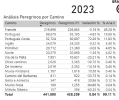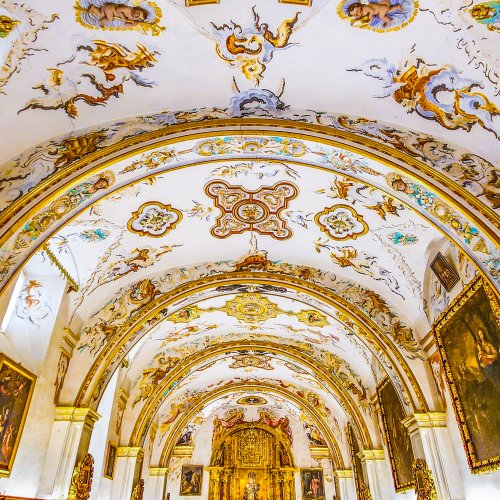@Bradypus,
Do you know if 2023 will be the first post-Holy-year-year in which the numbers have gone up instead of down? I thought that was a pretty regular phenomenon -- spike in Holy Year, then a decrease, but never back to the pre-Holy year level. And then the inching up till the next Holy Year spike.
This is correct BUT ignores the context that 2020-2022 was a very unusual period for world travel in recent history because of the Pandemic.
As a result, even though 2022 was a holy year the number of pilgrims was significantly less than in 2019.
In addition, The title of this thread and all discussion that compares 2023 pilgrim numbers with 2022 numbers without taking into account the context of the Pandemic on world travel and the shift in pilgrim numbers from the longer routes to shorter routes is presenting only a partial picture and is therefore misleading.
2019 was the last "normal" year prior to the pandemic. Looking at the period from 2017 through 2019 we see a relatively stable year on year increase in pilgrim numbers by around 8% a year, being 301,036 in 2017; 327,377 in 2018 and 347,566 in 2019. Note: all numbers sourced from Pilgrim Office in Santiago de Compostela via the excellent website
https://solviturambulando.es/en/el-camino-de-santiago/camino-de-santiago-stats/ which allows much better flexibility and is maintained by
@diegoromerosm
However these overall numbers mask some important shifts in pilgrims choice of route. Pilgrims starting in St. Jean were relatively stable with a slight dip in 2018 (33,177; 32,899; 33,193). Meanwhile the shorter Portuguese routes increased markedly in popularity with the coastal starting in Oporto, for example markedly increasing (2,634; 6,184; 11,421). Pilgrims starting in Sarria increased steadily (79,718; 88,509; 96,121). Pilgrims also displayed an increasing preference for the Ingles with numbers starting from Ferrol being (10,822; 13,335; 15,098). Overall all of the main shorter routes had significant increases year on year. In general the less popular longer routes such as the VDLP and others have such few numbers that they should be analysed separately.
Then the pandemic shut down national and international travel and the first year to exceed 2019 overall pilgrim numbers was 2022 and so this is the point where we might consider that pilgrims had returned to pre-pandemic habits. However, 2022 was a "Holy" year by decree and going on historical patterns we would have expected to see a largish increase over the overall 2019 numbers.
I did a paper based analysis of 2019; 2022 and 2023 figures with a breakdown into the most popular starting cities and into a rough seasonal breakdown of Spring (March-June); Summer (July-August) and Autumn (September -November). Being paper based it may have some errors but I did give it a quick check and I am reasonably confident in it. The rough seasonal breakdown is to try to see if international pilgrims (often walking in Spring and Autumn) are making different choices from Spanish pilgrims who mostly tend to walk in their Summer July-August holidays. In general, my theory is that Holy years influence Spanish pilgrims more than international pilgrims although I would assume that all pilgrim numbers tend to increase to some degree in a Holy year.
If there is a noticeable Holy year effect then I would expect to see a bigish jump from 2019 numbers to 2022 numbers and then a fall back from 2022 numbers in 2023.
During Spring (when there tends to be more international pilgrims I dont see that pattern. On the shorter routes I generally see a steady year on year increase, for example, Sarria (37,461; 44,943; 49,188); Tui (6,833; 9,589; 10,399); Ferrol (5,303; 6,629; (7,930). Something odd happened with the Portuguese Coastal starting in Oporto (4,267; 3,298; 7,241); the numbers dipped in 2022 then did a big jump to 2023. The Pilgrim Office in Santiago does a weird mixed analysis it tries to categorise by starting city but for the Portuguese routes where several can start in the same city of Oporto they break the numbers into Oporto (traditional) and Oporto Coastal. It may be possible that these two sets of numbers got cross contaminated in 2022. Looking at the numbers of pilgrims starting in St. Jean during Spring for 2019; 2022 and 2023 we see that in 2022 the numbers starting dropped markedly in 2022 and then recovered to 2019 levels in 2023 (13,531; 10,675; 13,800).
During the summer months of July and August we do see the expected pattern that has been noted in prior Holy years where the Holy year numbers are much higher then fall back again in the following year in all starting cities except St. Jean. Sarria for example is (33,006; 47,684; 41,270); Tui (10,479; 14,758; 12,793) and Ferrol (6,010; 9,974; 7,996). St. Jean shows a dip in numbers in 2022 which is maintained in 2023 (7,559; 6,175; 6,104). This highlights the probable different choices made by Spanish versus international pilgrims and it looks like some international pilgrims may be avoiding Holy years or else St. Jean has not recovered as a popular starting point.
During Autumn, another popular starting time for international pilgrims, particularly, I think, for North American pilgrims we see a steady growth in popularity for the shorter routes and a recovery to 2019 numbers for those starting in St. Jean. Sarria (24,045; 37,458;
34,475); Tui (5,217; 8,664; 9,512); Ferrol (3,483; 5,791; 6,550). St. Jean (11,357; 10,652; 11,226).
Overall I would say that we have seen the Holy year pattern on the shorter routes, particularly for those pilgrims starting in Sarria and particularly during summer when more Spanish pilgrims tend to walk. During periods popular with international pilgrims we see a big growth on the shorter routes particularly those routes associated with the Portuguese caminos. In the case of pilgrims starting in St. Jean the numbers have finally got back to where they were in 2019.
What this all means for 2024 is anyone's guess!
Edited to correct an incorrect statement and to add comments.

 www.elcorreogallego.es
www.elcorreogallego.es






















